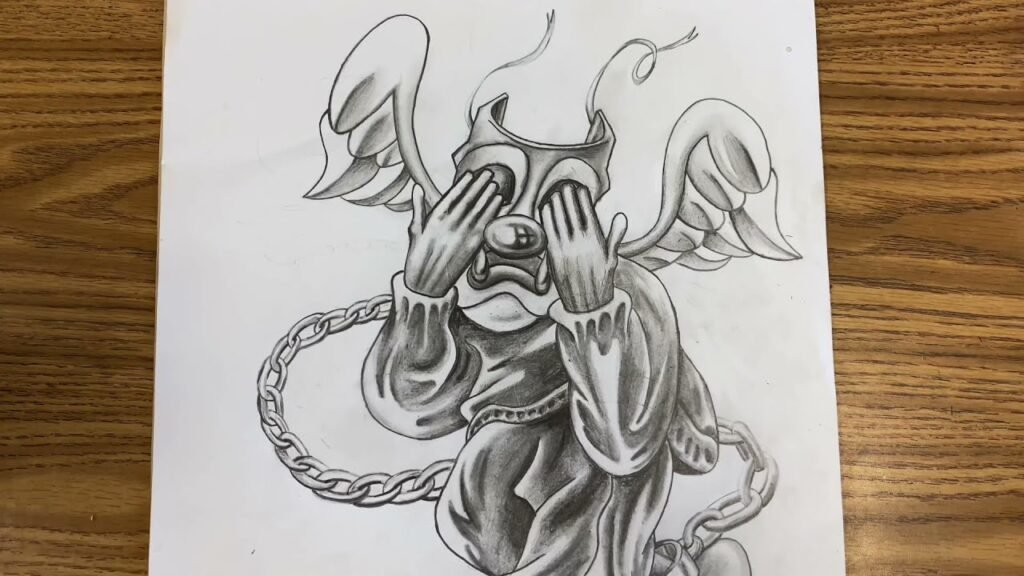Easy: CMZ3E8SHROM = Chicano Drawings? Chicano art is a powerful and expressive form of visual storytelling rooted deeply in the Mexican-American experience. It encapsulates a wide range of themes, from cultural pride to social justice, often reflecting the struggles and triumphs of Chicanos in the United States. One specific and intriguing subset of this movement is Chicano drawings. These intricate and symbolic pieces offer a window into the heart of Chicano identity, blending elements of traditional Mexican folk art with contemporary urban culture.
In this article, we will dive deep into the world of Chicano drawings, exploring their origins, cultural significance, key features, and how they’ve evolved in modern times. By the end, you’ll have a comprehensive understanding of this unique art form and how to create your own simple Chicano-inspired drawings. So, let’s get started!
1. The Origins of Chicano Drawings
Chicano drawings have their roots in the broader Chicano art movement, which began to flourish in the 1960s during the civil rights era. This movement sought to give a voice to Mexican-Americans who were advocating for equal rights, cultural recognition, and political change. Much of the art produced during this time was politically charged, aimed at resisting the oppression and marginalization that Chicanos faced in the United States.
Muralismo and its influence: One of the significant influences on Chicano art, including drawings, is Mexican muralism. Famous Mexican muralists like Diego Rivera and David Alfaro Siqueiros, who used art to convey political and social messages, inspired Chicano artists to create public works of art. These murals became central to the Chicano movement, and their techniques and styles often carried over into drawings.
Iconography and symbolism: Chicano drawings often include rich, symbolic imagery that reflects Mexican heritage. Indigenous symbols, religious figures such as the Virgin of Guadalupe, and Aztec motifs are commonly found in these drawings, symbolizing a deep connection to pre-Columbian roots.
2. Cultural Significance of Chicano Drawings
Chicano drawings are not merely about aesthetic beauty; they hold deep cultural meaning. They are a form of expression that gives voice to the Chicano experience, often addressing issues of identity, race, family, and resistance.
A celebration of heritage: At the heart of Chicano art is a celebration of Mexican culture. Chicano drawings often depict traditional Mexican motifs such as sugar skulls (calaveras), flowers, and religious imagery. These symbols serve as a way for Chicanos to honor their ancestry while asserting their identity in a predominantly Anglo-American society.
A tool for political expression: Chicano drawings, like much of Chicano art, can also be politically charged. Artists use this medium to express their frustrations with societal inequality, police brutality, and anti-immigrant sentiment. These drawings often serve as both personal expressions and collective statements for the larger Chicano community.
Gang culture and tattoos: Chicano drawings have also been linked with the Chicano gang culture that developed in the urban areas of the United States. Many gang members used tattoos and graffiti as a form of self-expression. These intricate, black-and-white line drawings often symbolized loyalty, family, and identity. The style used in tattoo designs often carries over into Chicano drawings, contributing to their bold and distinctive look.
3. Key Elements of Chicano Drawings
Chicano drawings have a distinct style that is immediately recognizable. Understanding the key elements of these drawings can help you appreciate the technique and cultural significance that goes into each piece.
Monochromatic tones: Many Chicano drawings are done in black and white or grayscale. This simplicity allows for an emphasis on the intricate line work and shading techniques that are central to the style. The monochromatic tones also give the drawings a raw, powerful aesthetic that complements the emotional weight of the subject matter.
Fine linework: One of the hallmarks of Chicano drawings is the use of fine, delicate lines to create detailed, intricate designs. These lines are often used to outline figures, add depth through shading, and create decorative patterns that enhance the overall composition. This style requires a steady hand and a keen eye for detail, but the results are stunning.
Symbolic imagery: Chicano drawings are filled with symbolic imagery. Religious icons such as the Virgin Mary, Day of the Dead skulls, roses, and Aztec symbols are commonly featured in these drawings. Each of these symbols carries deep meaning, reflecting the artist’s heritage, beliefs, or personal experiences.
Portraiture and realism: Many Chicano drawings focus on highly realistic portraits of people, often depicting family members, historical figures, or religious icons. These portraits are typically rendered with great attention to detail, capturing the emotion and essence of the subject. The faces often convey deep feelings of pride, struggle, or reverence, making them a powerful part of the overall composition.
4. The Evolution of Chicano Drawings in Modern Times
While Chicano drawings have their roots in the civil rights struggles of the 1960s and 1970s, they have evolved over time. Today, Chicano art continues to thrive, with artists blending traditional techniques with modern influences.
Digital art and Chicano drawings: As technology has advanced, so has the world of Chicano drawings. Many contemporary artists now use digital tools to create their art, allowing for even greater precision and experimentation. While the core elements of Chicano drawings remain the same, the medium has expanded to include digital platforms, making the art more accessible to a global audience.
Blending of styles: Modern Chicano artists often blend traditional elements with influences from other art forms, such as graffiti, street art, and lowrider culture. This fusion of styles has helped Chicano art remain relevant in today’s urban landscape, appealing to younger generations while honoring the past.
Social media and Chicano art: Social media platforms like Instagram and Pinterest have played a significant role in the spread of Chicano drawings. Artists can now share their work with a global audience, connect with other Chicano artists, and inspire a new generation to explore their cultural heritage through art.
5. How to Create Your Own Chicano Drawings
Creating your own Chicano drawings can be a rewarding experience, allowing you to express your creativity while paying homage to a rich cultural tradition. Here are some simple steps to get started:
Step 1: Gather Your Materials
- Pencils or pens: Since most Chicano drawings are done in black and white, you’ll want to start with simple drawing tools. Pencils allow for shading and fine lines, while pens provide bold, clean outlines.
- Paper: Choose a smooth, high-quality paper that can handle detailed line work.
- Reference images: If you’re new to Chicano art, it can be helpful to have reference images of traditional motifs, such as sugar skulls, roses, or religious icons, to guide your drawing.
Step 2: Start with Basic Shapes
Begin your drawing by sketching out the basic shapes of your design. If you’re creating a portrait, focus on the proportions of the face and body. For symbolic imagery, like roses or skulls, start with the general outline before adding in details.
Step 3: Add Detail and Symbolism
Once you’ve laid down the basic shapes, start adding in details. Pay attention to line work, as this is a key element of Chicano drawings. Use fine lines to create intricate patterns, shading, and textures that give your drawing depth.
Incorporate symbolic imagery into your drawing to make it more meaningful. Whether it’s a religious icon, an Aztec symbol, or a simple rose, each symbol adds layers of meaning to your artwork.
Step 4: Focus on Shading and Depth
Shading is essential in Chicano drawings, as it adds depth and dimension to your artwork. Use cross-hatching, stippling, or soft shading techniques to give your drawing a three-dimensional feel. Be patient with this step, as it can take time to build up the layers of shading needed for a realistic effect.
Step 5: Finalize Your Drawing
Once you’re satisfied with the details and shading, go over the lines one last time to clean up any smudges or inconsistencies. Your Chicano drawing is now complete! Don’t be afraid to experiment with different symbols and styles as you develop your own unique take on Chicano art.
6. The Legacy of Chicano Drawings
Chicano drawings are more than just beautiful works of art; they are a testament to the resilience, creativity, and pride of the Chicano community. These drawings continue to inspire artists and art lovers alike, reminding us of the power of art to tell stories, challenge the status quo, and preserve cultural heritage.
As you explore the world of Chicano drawings, remember that each piece holds a deeper meaning, reflecting the complex and vibrant identity of the Chicano people. Whether you’re an artist or an admirer, there’s no denying the profound impact of Chicano art on the broader artistic landscape.
In conclusion, Chicano drawings stand as a vibrant symbol of cultural pride, personal expression, and resistance. From their origins in the civil rights movement to their modern-day evolution, these intricate works of art continue to inspire and captivate. Whether you’re looking to create your own Chicano-inspired drawings or simply appreciate the beauty and meaning behind them, there’s no better time to immerse yourself in this rich cultural tradition.



